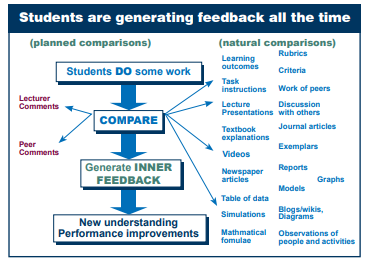What is meant by "self-assessment"
 When we talk about ‘self-assessment’ concerning the teaching of students, we mainly mean that as a teacher we encourage and enable students to reflect on their growing skills and knowledge, learning goals and processes, products of their learning, and progress in the course1. Learning students the skills to self-assess contributes to the development of transferable lifelong skills, such as metacognitive skills and reflective thinking, and stimulates students to regulate their learning process and become self-directed learners.
When we talk about ‘self-assessment’ concerning the teaching of students, we mainly mean that as a teacher we encourage and enable students to reflect on their growing skills and knowledge, learning goals and processes, products of their learning, and progress in the course1. Learning students the skills to self-assess contributes to the development of transferable lifelong skills, such as metacognitive skills and reflective thinking, and stimulates students to regulate their learning process and become self-directed learners.
Self-assessment can be related to predetermined performance criteria for all students, but also to personal learning goals determined by each student.
Although the term "self-assessment" is very common, it doesn't need to be related to grading. More often, it is used as a formative strategy, to support the students in their learning and development process and help them to improve their performance.
How self-assessment can contribute to efficiency
Self-assessment activities benefit teachers too in terms of efficiency and effectiveness in guiding and assessing students. For instance if, as a teacher, you can stimulate students to reflect on and critically evaluate their progress, and skill development, identify gaps in their understanding and capabilities, and reflect on their work so that they know how to improve this before submitting it, this will save time spent on guidance and feedback and it gives a better chance of requirements and objectives being met in the end. But..., self-assessment activities also need guidance and practice.
There are a lot of ways students can be engaged in self-assessments. These can be low-stake activities, such as a quiz during a lecture by way of students can see whether they have understood the theory. Or high-stake activities, for which students might also get a grade, for instance having students produce a reflective report about their learning process and achievements or produce a reflective lab journal.
On this page, we focus on how self-assessment activities can be used for enhancing the quality of performance and deliverables. Thereby contributing to the effectiveness and efficiency of the assessment process of the teacher.
| Something to consider: Inner feedback happens all the timeComments from teachers or peers do not constitute feedback until students process them, compare their interpretation of them against their work or performance, and generate new knowledge and understanding out of that comparison. The input is used to generate inner feedback. However, students generate inner feedback all the time, e.g. by comparing their thinking, actions, and work against external information in different kinds of resources, in guidance documents, journal articles, rubrics, textbooks, videos, and diagrams, and derived from observations of activities and others’ behavior. The question is: How can we unlock the potential of inner feedback? Help students to improve their capacity to generate inner feedback? |
1 Definition from Student Self-assessment | Center for Teaching & Learning | University of Colorado Boulder
Used and useful resources:
- How to harness the power of self-assessment for students - Vrije Universiteit Amsterdam (vu.nl)
- Guide to self-assessment. University of Dublin, Trinity College

